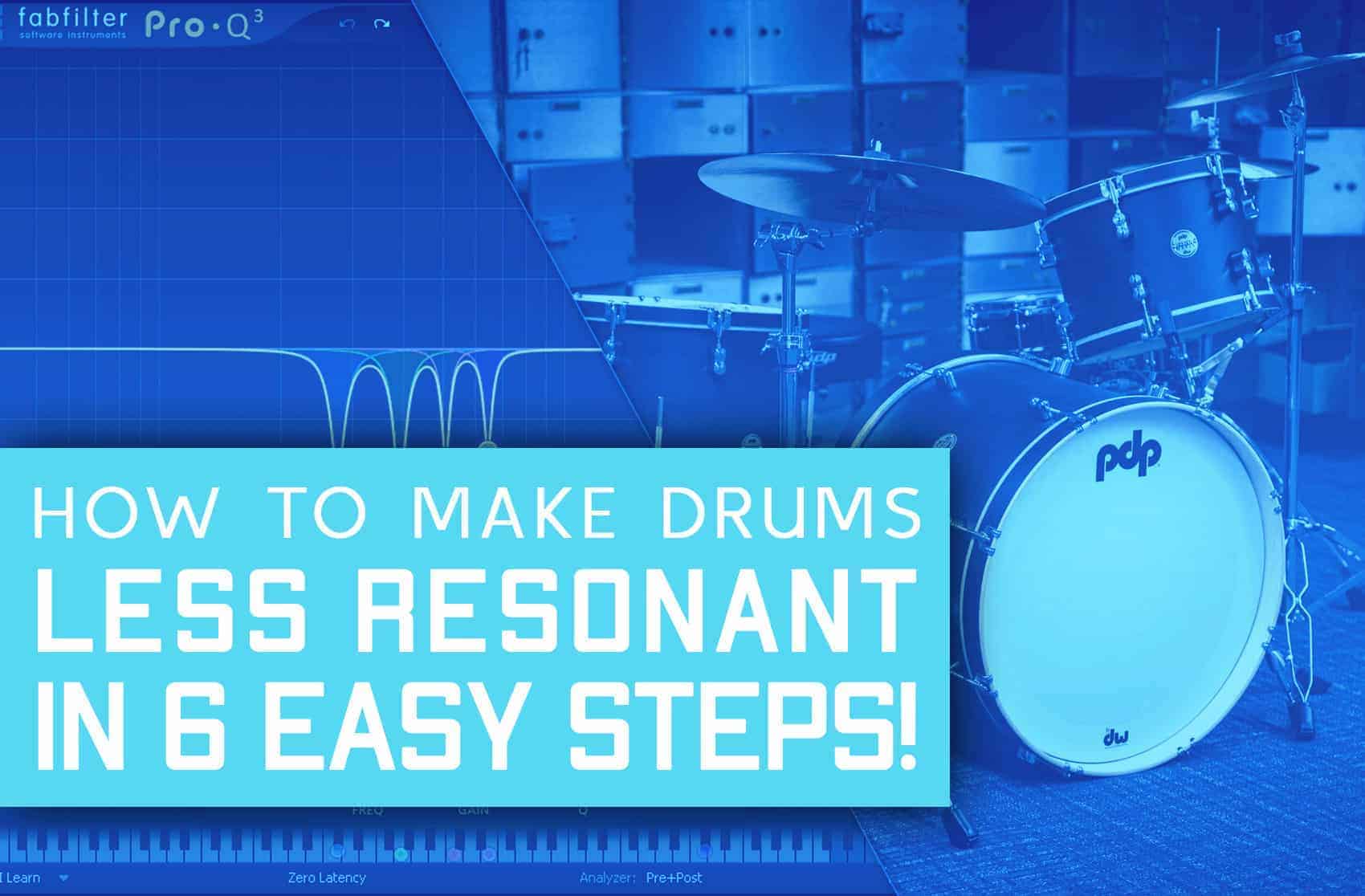Drum resonance can be a real disaster, and knowing how to fix problems can save the day in the studio or at a gig It’s not always possible, but dealing with the problems as early as you can is always the best option.
This is one of the problems you usually don’t know that you have, but really ruins your track in the mean while. Actually, when I started to produce music, it was really hard to even identify the problem.
But, as more time went by, I did my research and discovered how to avoid resonant drums altogether, and how to fix them in post if avoiding wasn’t possible. So, in this article, I’ll show you how to avoid, and fix resonant drums in post.
Why Don’t We Want Resonant Drums?
The resonance of drums is a key part of their sound, and it can be a really important attribute to get right in your recordings. Drum resonance can be the difference between a mix sounding polished and together, or a complete ring-y mess.
Almost every drummer in the world will have experienced some unpleasant drum resonance at some point in their lives. Whether that’s endless snare buzz, toms sounding when other elements of the kit are hit, or simply drums that ring out on certain frequencies for far too long.
Dealing with the drums can be a bit of a nightmare at times, but there are lots of ways to help fix the problem. As with most problems in audio, it’s best to fix them as early as possible in the process, so if you’re recording your own drums – make sure the drums and the room are tuned and treated as well as they can be.
Step #1: Change The Source Material Or The Room
Applying damping to drum heads can often be the most effective way to get rid of unwanted resonance, although sometimes this can cause almost as many problems as the resonance itself if not dealt with well.
Applying damping is essentially reducing the tone of the drums, so often it’s best applied with some moderation – depending on the stylistic characteristics of the music you intend to make.
Drum heads and tuning is another really important aspect of taming unwanted resonance. Most of the sound of drums comes from the drum head – so it’s not to be underestimated.
Ensuring your drum heads are centered and tuned well can stop them from vibrating at the resonant frequencies of other elements of the kit. Using new heads is going to give the best tone, but more than likely the most resonance.

Changing batter heads a day or two before a recording session is the optimum time – then they’re fresh and new but bedded in enough to provide a consistent sound throughout the recording.
The choice of drum head is very important too. Drum heads are typically available as either single ply or double ply. Single ply will usually be much more resonant than double. Pre-damped heads are also available, with varying different amounts of damping.
Another element that can affect the resonance of your drums is the room they’re being played in.
If the room is full of parallel walls and hard surfaces with little to no absorption, then standing waves can form in the room, and causes drums to sound very resonant indeed. Being in a treated room, or having a basic knowledge of room acoustics can really help with this.
If treating the room or the kit aren’t possible, we’ll look at some other ways to help fix resonance below.
Step #2: Apply Noise Gating
Applying noise gates to drums is a classic way of reducing the resonance. It’s been used on countless records, and is still one of the go to approaches for live sound engineers when treating the drum kit isn’t an option.
A noise gate only allows audio to pass through it when it reaches a certain threshold, and then when the level of audio drops below that threshold, the gate will shut again, meaning no noise can pass through again.
Gates have attack and release parameters, just like a compressor, and these are particularly important with drums.
Setting a noise gate to allow the initial transient (high amplitude sound at the start of the drum hit) through, and then cut off at an appropriate point within the resonance will allow you to deal with any problems accurately and easily.
When applying a noise gate to drums, it’s important to have a quick attack time. If the attack time is too slow, the initial transient of the drum will be missed, and will result in the drums having no punch or impact.
Step #3: Use EQ & Dynamic EQ
Applying EQ to fix drum resonance is probably a very obvious solution, but it still works well. Listening for the specific frequency that is causing the ring takes skill, but it’s a very effective solution.
This again, is very common practice in a live sound environment. The frequency you’re looking for is usually the fundamental of the drum, and can often be found somewhere between 100-300Hz on a tom.
If you’re not too confident using your ears to pinpoint certain frequencies yet, then an EQ with an RTA, or real time analysis, will come in very handy. RTAs are common on most EQs, and within DAWs there is often a stock option with an RTA: Channel EQ in Logic, EQ Eight in Ableton etc.
An RTA will display any frequencies that are sounding in your source material, and it’s usually quite easy to spot resonance on drums – it’s the big peak that takes a while to fall down after the drum has been hit.

Using a fully parametric EQ , something like Fab Filter Pro Q 3, is advisable for this type of process, as you’ll want to keep the Q value as narrow as possible so you don’t negatively impact the rest of the frequencies within the drum sound.
A slightly more advanced solution to treating drum resonance with EQ is by using a dynamic EQ. Dynamic EQs have thresholds within each of their bands, which mean the band will only spring into action when the threshold is met.
This can be a great way of preserving the tone of your drum, and only affecting the resonance when it needs to be affected. This is also a more workable approach on sources like overheads, where there is more than one element within the audio.
Step #4: Transient Designer

Transient designers, or transient shapers, work to control the attack and release of certain sounds through a combination of compression and expansion.
Expanders are essentially the opposite of compressors, or compressors with a negative ratio. This means rather than reducing the dynamic range of audio, they will actually increase the distance between the lowest and highest volumes.
Transient designers are great for altering the character of an audio signal at either wide of each transient. They work better on transient heavy material – so things like drums and percussion are perfect for them.
Transient designers tend to have 2 main controls: attack and release/ sustain. The attack control applies expansion as the start of a transient, to give even more of a sense of punch and impact, as each transient will have more dynamic range within the hit.
The release or sustain control reduces the length of the tail of the audio, and can help it fade out more quickly, again through the use of compression and expansion.
Using transient designers on drums can be great to minimize resonance, as well as to give them even more punch, and, best of all, they’re really easy to use and play around with!
Step #5: Use Audio Editing Techniques
This is a bit of a longer approach if you’re recording acoustic drums for a full track, but if you’re using samples, or if you’ve made your own samples, then this is a simple approach to help things.
Altering each individual sample you’re using by chopping it differently, or using fades, can give you a ton of control over the resultant sound.
Chopping the start of drum samples so they begin right on the transient will make them sound more punchy and clicky, and cutting them earlier can reduce resonance.

It’s easy to get artefacts when editing drum samples by chopping, so using fades can be a great way to get around this. Fading in a drum sample at the start can reduce the attack, or make it sound softer.
Fading one out at the end can help the ending feel smoother, and again further reduce resonance. This approach would be hugely time consuming for an entire track – but it can be a reliable and accurate way of sorting hits in a sampler.
Step #6: Use Sample Enhancement
This last step is a bit of a cheat, and I’d be hesitant to recommend it solely for the purpose of dealing with drum resonance, as it’s likely to change your drum timbre quite significantly.
Sample enhancement or replacement is commonplace within most music genres, and it’s essentially the process of layering a pre-existing drum sample over the top of whatever you currently have.
There are various plugins that will do it for you, and some DAWs have a built in MIDI layering system to allow you to layer samples, such as Logic and Ableton. How you blend the samples with your raw material is completely up to you.
Sometimes using a small percentage of sample works well to give your drum hits more consistency and fullness, but other times it can be nice to give the sample a lot of prominence.
If you’re really struggling with resonance and some of the other steps aren’t helping you – this could be your option.







